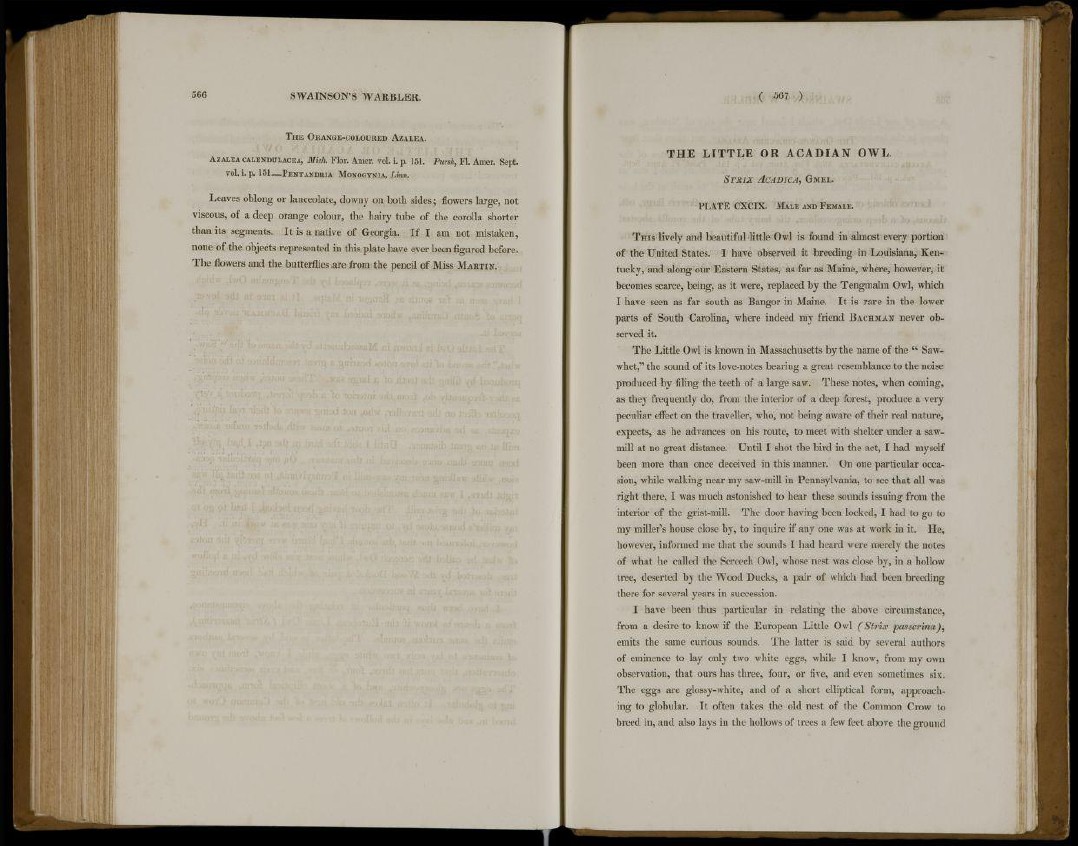
566 S W A I N S O N ' S W A R B L E R .
THE ORANGE-COLOURED AZALEA.
AZALEA CALENDULACEA, Mich. Flor. Anier. vol. i. p. 151. Pursh, Fl. Amer. Sept.
vol. i. p. 151,—PENTANDRIA MONOGYNIA, Linn.
Leaves oblong or lanceolate, downy on both sides; flowers large, not
viscous, of a deep orange colour, the hairy tube of the corolla shorter
than its segments. It is a native of Georgia. If I am not mistaken,
none of the objects represented in this plate have ever been figured before.
The flowers and the butterflies .are from the pencil of Miss MARTIN.
( 567 )
T H E L I T T L E OR A C A D I A N OWL.
STRIX ACABICA, GMEL.
P L A T E C X C I X . MALE AND FEMALE.
THIS lively and beautiful little Owl is found in almost every portion
of the United States. I have observed it breeding in Louisiana, Kentucky,
and along our Eastern States, as far as Maine, where, however, it
becomes scarce, being, as it were, replaced by the Tengmalm Owl, which
I have seen as far south as Bangor in Maine. It is rare in the lower
parts of South Carolina, where indeed my friend BACHMAN never observed
it.
The Little Owl is known in Massachusetts by the name of the " Sawwhet,
1'' the sound of its love-notes bearing a great resemblance to the noise
produced by filing the teeth of a large saw. These notes, when coming,
as they frequently do, from the interior of a deep forest, produce a very
peculiar effect on the traveller, who, not being aware of their real nature,
expects, as he advances on his route, to meet with shelter under a sawmill
at no great distance. Until I shot the bird in the act, I had myself
been more than once deceived in this manner. On one particular occasion,
while walking near my saw-mill in Pennsylvania, to see that all was
right there, I was much astonished to hear these sounds issuing from the
interior of the grist-mill. The door having been locked, I had to go to
my miller's house close by, to inquire if any one was at work in it. He,
however, informed me that the sounds I had heard were merely the notes
of what he called the Screech Owl, whose nest was close by, in a hollow
tree, deserted by the Wood Ducks, a pair of which had been breeding
there for several years in succession.
I have been thus particular in relating the above circumstance,
from a desire to know if the European Little Owl (Sti'ix passerina),
emits the same curious sounds. The latter is said by several authors
of eminence to lay only two white eggs, while I know, from my own
observation, that ours has three, four, or five, and even sometimes six.
The eggs are glossy-white, and of a short elliptical form, approaching
to globular. It often takes the old nest of the Common Crow to
breed in, and also lays in the hollows of trees a few feet above the ground